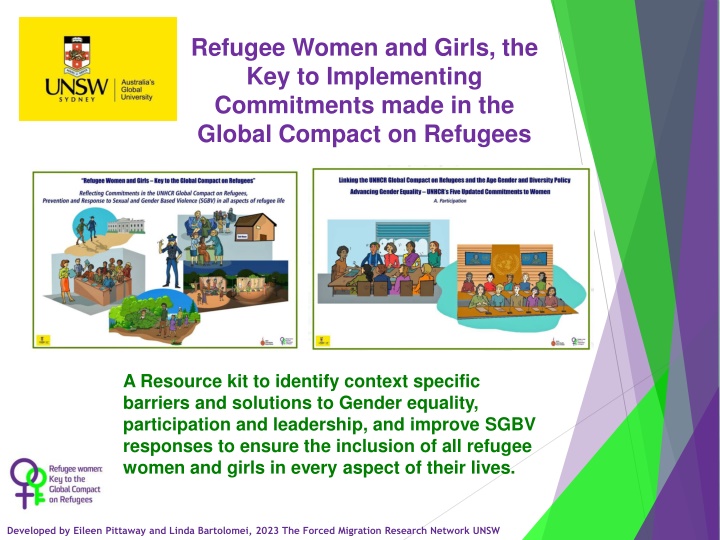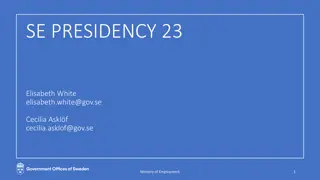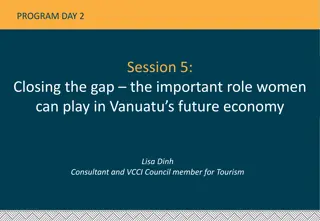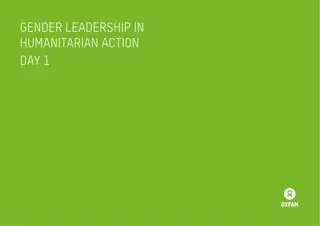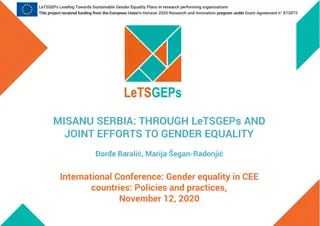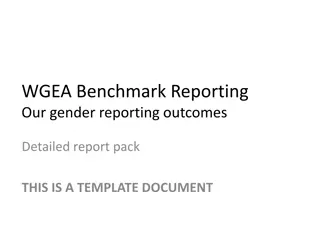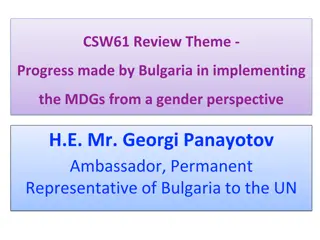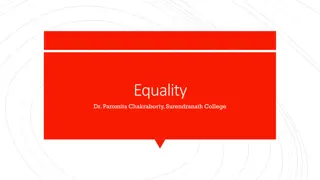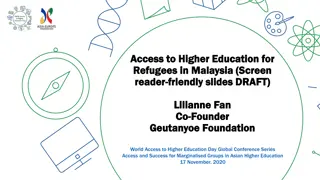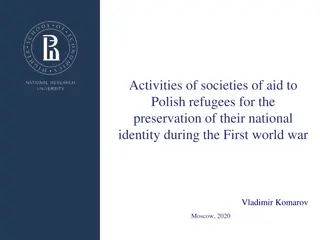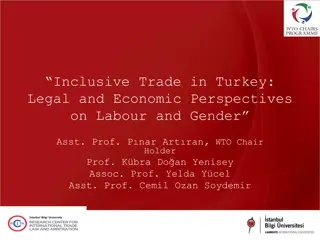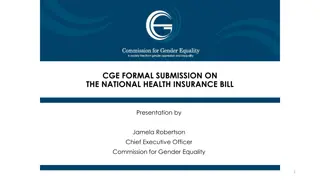Gender Equality in Global Compact on Refugees
The Global Compact on Refugees emphasizes promoting gender equality, empowering women and girls, combating gender-based violence, and ensuring inclusivity for all refugee women and girls. It sets out commitments to protect human rights, provide healthcare services, and facilitate diverse participation within refugee communities.
Download Presentation

Please find below an Image/Link to download the presentation.
The content on the website is provided AS IS for your information and personal use only. It may not be sold, licensed, or shared on other websites without obtaining consent from the author.If you encounter any issues during the download, it is possible that the publisher has removed the file from their server.
You are allowed to download the files provided on this website for personal or commercial use, subject to the condition that they are used lawfully. All files are the property of their respective owners.
The content on the website is provided AS IS for your information and personal use only. It may not be sold, licensed, or shared on other websites without obtaining consent from the author.
E N D
Presentation Transcript
Refugee Women and Girls, the Key to Implementing Commitments made in the Global Compact on Refugees A Resource kit to identify context specific barriers and solutions to Gender equality, participation and leadership, and improve SGBV responses to ensure the inclusion of all refugee women and girls in every aspect of their lives. Developed by Eileen Pittaway and Linda Bartolomei, 2023 The Forced Migration Research Network UNSW
What is the Global Compact on Refugees? In the 2016 historic New York Declaration for Refugees and Migrants, all 193 Member States agreed that protecting those who are forced to flee and supporting the countries that shelter them are shared international responsibilities that must be borne more equitably and predictably. Its commitments included: Promotion of gender equality and the empowerment of all women and girls Fully respecting and protecting the human rights of women and girls Combatting sexual and gender-based violence Provision of access to sexual and reproductive health-care services Intellectual property of E Pittaway and L. Bartolomei; Reuse is permitted with author attribution
The Global Compact on Refugees and Gender The Declaration gave UNHCR the task of to develop a Global Compact on Refugees to operationalise the principles set out in the Comprehensive Refugee Response Framework (CRRF). UNHCR held consultations with governments and other stakeholders to develop the Compact. The work of international scholars was recognised and incorporated A UNSW Gender Audit team which included 7 refugee women advocates worked with UNHCR to make sure that the final text of the GCR included strong commitments to refugee women and girls Intellectual property of E Pittaway and L. Bartolomei; Reuse is permitted with author attribution
What are the Gender Commitments? Para 13 The programme of action is underpinned by a strong partnership and participatory approach, involving refugees and host communities, as well as age, gender, and diversity considerations, including: promoting gender equality and empowering women and girls; ending all forms of sexual and gender-based violence, trafficking in persons, sexual exploitation and abuse, and harmful practices; facilitating the meaningful participation of youth, persons with disabilities and older persons; ensuring the best interests of the child; and combating discrimination. See UNHCR Executive Committee (ExCom) Conclusion No. 108 (LIX) (2008), (f)-(k). Global Compact on Refugees. 2018 See UNHCR Executive Committee (ExCom) Conclusion No. 108 (LIX) (2008), (f)-(k). Global Compact on Refugees, 2018 Intellectual property of E Pittaway and L. Bartolomei; Reuse is permitted with author attribution
Where did the idea for the Kit come from, and why is it so complex? Each module is based on findings from research on the implementation of the gender commitments in the Global Compact on Refugees (GCR), with a main focus on the Meaningful Participation of Refugee Women and Girls, and an Effective Response to SGBV. They were developed with refugee women s groups in Thailand, Bangladesh, and Malaysia who worked with us as project partners. Intellectual property of E Pittaway and L. Bartolomei; Reuse is permitted with author attribution
An Intersectional approach For ease of use, we have broken the material into training sessions, but in fact we have taken an intersectional approach to the analysis. None of the sections can just stand alone as an answer to the challenges faced by refugee women, and to women led refugee organisations. Together they represent the complex number of issues which have to be addressed. Intellectual property of E Pittaway and L. Bartolomei; Reuse is permitted with author attribution
An Investment in time While to use these tools as part of program planning and design takes time, we argue that the investment will pay dividends. Cutting corners, assuming knowledge and most importantly, not including refugee and displaced women and girls in the process of analysis and planning could lead to failed programs. We hope that this tool will contribute to better program design, implementation and evaluation. Intellectual property of E Pittaway and L. Bartolomei; Reuse is permitted with author attribution
What IS this Resource Kit? It is an iterative resource which will continue to be developed and improved through a series of workshops. It is based on our on- going work, and the analysis is ours. For this reason, we have used the first person to introduce the materials to you. It will be available on an interactive website on which we invite all stakeholders to share suggestions for adaptations and or extensions based on their experiences of using the tool and resources and to showcase examples of own good practice Intellectual property of E Pittaway and L. Bartolomei; Reuse is permitted with author attribution
From Rhetoric To Reality Refugee Participation, Women s Refugee Led Organisations, Lived Experience, An Effective response to Sexual and Gender Based Violence, A Human Rights Based Approach, Gender Equality, Age Gender and Diversity and Community Development, from Humanitarian Aid to Development models are all buzz words and phrases in the current discourse about refugee protection. They are all reflected in the aspirations and commitments in the Global Compact on Refugees and come under the broad umbrella of Social Inclusion Intellectual property of E Pittaway and L. Bartolomei; Reuse is permitted with author attribution
Social inclusion refers to the active and meaningful participation of refugees in the social, economic, cultural, and political aspects of the host society. It takes a human rights approach, treating refugees with respect, fostering a sense of belonging and empowering them to contribute positively to society at a local national and international level, through their inclusion and advocacy. Intellectual property of E Pittaway and L. Bartolomei; Reuse is permitted with author attribution
These concepts are easy to say, but often very difficult to define and implement. Sadly, because of this, and despite the good intent, they are often just words or acronyms, easy to tick as acknowledged in policy, but absent in program design and implementation. This Resource and suite of Tools has been developed as an outcome of 5 years of research with refugee groups, and a wide range of key stakeholders. It provides a framework for practitioners to develop workable definitions of each of these concepts, and to apply them effectively in the field. They cannot be separated out, they are interlinked, and need to be addressed collectively. Unless this happens little can change Intellectual property of E Pittaway and L. Bartolomei; Reuse is permitted with author attribution
Key findings from our research Sexual and Gender Based Violence (SGBV) is a/the major barrier to Gender Equality. Meaningful participation for women and girls is not possible without gender equality. Gender equality is not possible unless we acknowledge and address SGBV. Intellectual property of E Pittaway and L. Bartolomei; Reuse is permitted with author attribution
Major Barriers To Meaningful Participation Structural barriers to meaningful participation and gender equality. Local political, socio-economic and contexts. Cultural positions on SGBV and women s equality. The unwillingness of some key stakeholders to share power. Lack of resources to assess and deliver the levels of support needed by refugee women to achieve meaningful participation. Lack of definitions of key concepts used in major policy documents and law. Lack of flexibility by donors and host governments. Intellectual property of E Pittaway and L. Bartolomei; Reuse is permitted with author attribution
Three Models of Participation identified in our research 1. Fully refugee- women led, which means that WRLOs are able to receive and manage their own funding. 2. A collaborative model, where WRLOs work in partnership with trained supportive local service providers, including UNHCR, but design and deliver the services themselves. 3. Refugee Informed, where WRLOs and refugee women s groups are consulted about the services to be provided and are involved in service delivery as far as the local conditions allow, but not refugee-led. We know there are many more and if you have other models, we would love to share them, accredited of course, on this web page. Intellectual property of E Pittaway and L. Bartolomei; Reuse is permitted with author attribution
The Resource Kit addresses these key findings, linking Gender Equality and an effective response to SGBV It is designed to assist stakeholders such as Refugee- led Organisations, local and international NGOs, UN agencies and donors to make a realistic assessment of what is achievable in each place in which they work. It builds on the research findings from the project described above. Intellectual property of E Pittaway and L. Bartolomei; Reuse is permitted with author attribution
The set of tools addresses the major barriers to women s participation, gender equality and SGBV identified in so much of the research we have discussed. It speaks to the notion that One size does not fit all and enables stakeholders to identify the models of service provision most likely to succeed in any give space and time. Each section contains tools, exercises and information sheets, referenced to academic research. Intellectual property of E Pittaway and L. Bartolomei; Reuse is permitted with author attribution
TOOLS IN THE RESOURCE KIT Challenges faced by WRLOs 1. Structural Barriers, including registration, for WRLOs 2. Understanding Gender Equality 3.Gender-based Social Barriers for WRLOs 4. Age, Gender and Diversity 5. Identifying the impacts of Sexual and Gender Based Violence 6. Harnessing Lived Experience 7. Working with Refugee Men as Partners in Gender Equality 8. Meaningful Participation 9.Effective Partnerships 10. The Power of Privilege 11. From Humanitarian Aid to Human Rights Based Community Development 12. Succession Planning 14. Using an Intersectional approach to Develop a Strategic Plan 13. Collective Working, Consortiums and Governance Intellectual property of E Pittaway and L. Bartolomei; Reuse is permitted with author attribution
Structural Barriers 1. We first examine the potential of, and challenges to women refugee led work, with a focus on the key structural issues, the differences between registered and unregistered refugee led groups and what impact this has on their ability to function effectively and to receive funding. In sites where refugee led organisation are allowed to register, many, but certainly not all of these barriers addressed but it is still not easy being a minority group dependent on the good-will of others. Intellectual property of E Pittaway and L. Bartolomei; Reuse is permitted with author attribution
Gender Equality In the context of these resources, we have defined Gender equality as equal access to resources and opportunities, including economic participation and decision-making regardless of gender. It means respecting all people without discrimination, and addressing gender inequalities that limit a person's ability to access their human rights It does not require that girls and boys, or women and men, be the same, or that they be treated exactly alike. Intellectual property of E Pittaway and L. Bartolomei; Reuse is permitted with author attribution
Gender Inequality Gender Based Social issues also can cause major barriers. Many women lack access and opportunity to attend education and training about human rights, gender equality, sexual and gender-based violence and other life skills. They are also excluded from practical courses such as how to run organisations and projects. Culture, socio-economic circumstances and literacy levels also can pose barriers to participation. These social issues must be addressed along with the structural issues. Intellectual property of E Pittaway and L. Bartolomei; Reuse is permitted with author attribution
Age, Gender and Diversity The Age, Gender and Diversity or AGD approach is a UNHCR Policy that recognises people who are refugees, forcibly displaced and/or stateless are very diverse. They include people of all ages, genders, nationalities, religions, disability status, sexual orientation, as well as national, ethnic, religious, linguistic minorities and Indigenous peoples. It states that they must all be treated equally. This tool is designed to identify the different needs of the diverse groups living in each site, and work with them to identify their specific needs. Intellectual property of E Pittaway and L. Bartolomei; Reuse is permitted with author attribution
Sexual and Gender Based Violence In every site in which we have worked in this project and in 22 other countries over 25 years, women have identified rape, gender-based violence and sexual harassment (SGBV) as THE major barrier to participation, and gender equality in all aspects of their lives. (Pittaway and Bartolomei 2023). It is essential that we identify exactly HOW SGBV impacts on women s potential participation in each site and explore solutions with the women. Intellectual property of E Pittaway and L. Bartolomei; Reuse is permitted with author attribution
Lived Experience There is a welcome focus by policy makers and many service providers on ensuring that the lived experience of refugees is included in meetings and policy debates. We need to ensure that the lived experience of ALL refugees is heard and respected and take targeted steps to ensure that people of all genders, with diverse backgrounds and experiences are sought out and supported to contribute equally to the process. This can be challenging for a number of reasons, and we explore ways to achieve this. Intellectual property of E Pittaway and L. Bartolomei; Reuse is permitted with author attribution
Including Refugee Men This session addresses how to effectively include men in tackling gender inequality and ensure their needs are also met. While many needs are common, women and men, girls and boys and non- binary individuals have specific challenges, and they all should to be addressed. That is the aim of gender equality. Intellectual property of E Pittaway and L. Bartolomei; Reuse is permitted with author attribution
Meaningful Participation The notion of Meaningful participation is often ill- defined and multi-layered. It involves ceding power from the dominant group of stakeholders, i.e. host and donor governments, and humanitarian aid providers at all levels, and sharing it with the refugee communities. Different models must be developed to adapt to local circumstances. Intellectual property of E Pittaway and L. Bartolomei; Reuse is permitted with author attribution
Effective partnership Genuine Partnership is an important aspect of participation. It entails recognizing what each group brings to the relationship, a willingness to share power and privilege, and working out together how best to use these resources. Mutual obligations, transparency and accountability must be explicit and adhered to by all parties. The tools explore ways of building trust, which is a critical element in the process. Intellectual property of E Pittaway and L. Bartolomei; Reuse is permitted with author attribution
The power of privilege This is probably the most confronting of all the Tools. One of the most difficult challenges in implementing these GCR commitments is for All stakeholders to acknowledge white , gender and class privilege and how this is used or abused. It involves letting go of power, at a personal level, i.e. individual staff, organisationally, in policy and practise and by donors. In some cases, it requires using that privilege to support refugee groups. It means examining our own biases and negative assumptions, which are so often based on privilege or lack of power. It has to be acknowledged at a local and an international level. Intellectual property of E Pittaway and L. Bartolomei; Reuse is permitted with author attribution
From Humanitarian Aid to Development In order to achieve these often-aspirational goals, more progress is needed to shift the focus and approach of aid provision in refugee contexts from humanitarian to rights based and inclusive development approaches, which incorporate the key principles of community development. This challenge is exacerbated by the loss of legal rights and citizenship. We examine ways in which to make this shift. Intellectual property of E Pittaway and L. Bartolomei; Reuse is permitted with author attribution
Succession Planning In an evaluation of the project on which this kit is based, all stakeholders identified the need for Succession Planning to be part of the governance structure of WRLOs. This is to ensure that there are new leaders, trained and experienced to develop and lead new projects, and to take on management positions if current leaders are resettled, or leave position for other reasons Intellectual property of E Pittaway and L. Bartolomei; Reuse is permitted with author attribution
Legal Aspects of Collective working, and Consortiums In order demonstrate their ability to work professionally, develop good governance structures to be competitive for international funding, even without formal registration, it will become increasingly important for RLOs and WRLOs to develop and adopt transparent and accountable structures, and at times work together in collective groups. This training kit was developed for women's groups in this project by a Malaysian consultant, specific to Malaysia. It offers a template which can be adapted for other country sites. Intellectual property of E Pittaway and L. Bartolomei; Reuse is permitted with author attribution
Strategic Planning with an Intersectional Approach In acknowledging the intersectionality of the concepts addressed in these resources, we have mentioned the cross- cutting themes whenever appropriate in each section. The final Tool, Strategic planning, uses an intersectional approach to inform the development of models which address the intersecting challenges. Unless these are identified in each site, implementing these goals will continue to be challenging. Intellectual property of E Pittaway and L. Bartolomei; Reuse is permitted with author attribution
Training on the Resource Kit can be offered as a series of virtual workshops, or as a three-day face to face workshop. Contact Linda.Bartolomei@unsw.edu.au for details Intellectual property of E Pittaway and L. Bartolomei; Reuse is permitted with author attribution
